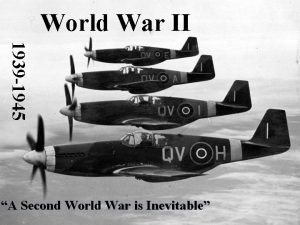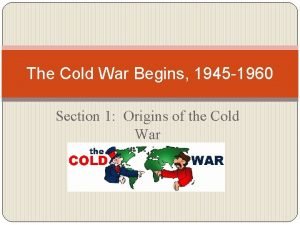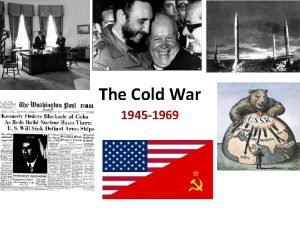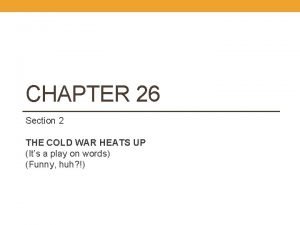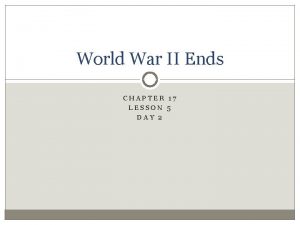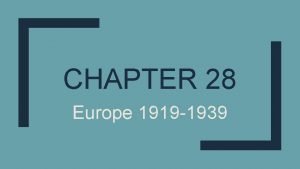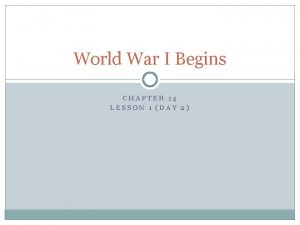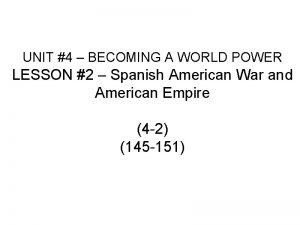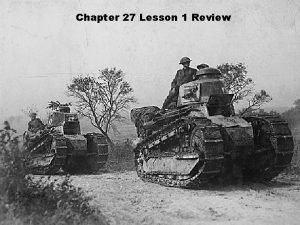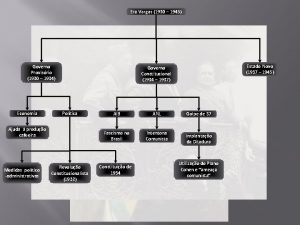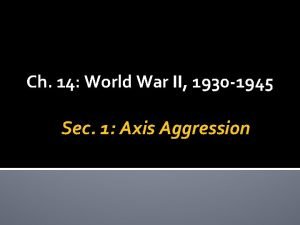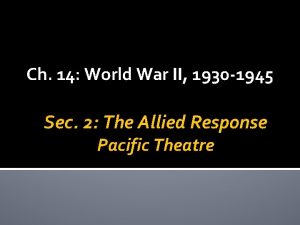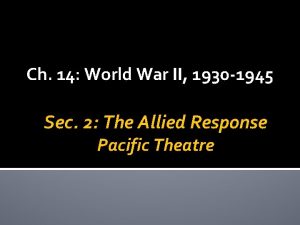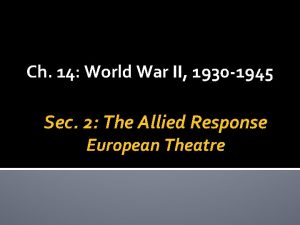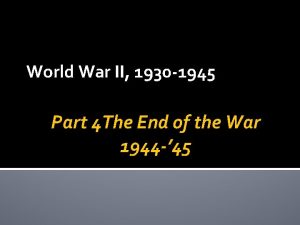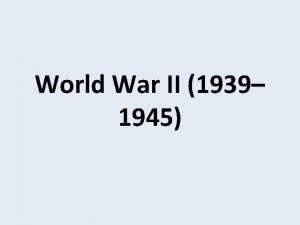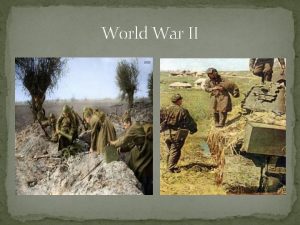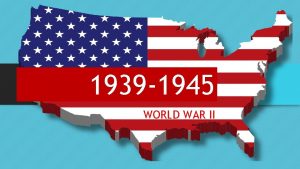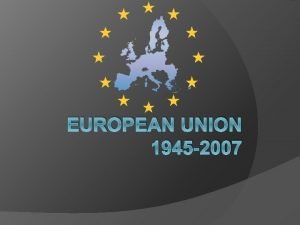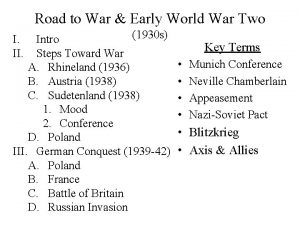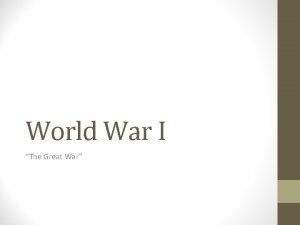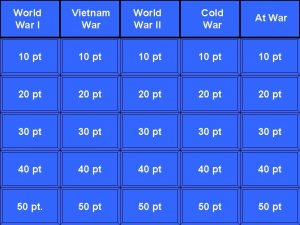World War II 1930 1945 Lesson 4 The



















- Slides: 19

World War II (1930– 1945) Lesson 4 The Allies Turn the Tide

World War II (1930– 1945) Lesson 4 The Allies Turn the Tide Learning Objectives • • • Understand how nations committed all of their resources to fighting World War II. Explain how the Allies began to push back the Axis powers in Europe and the Pacific. Describe the Normandy landings and the Allied advance toward Germany.

World War II (1930– 1945) Lesson 4 The Allies Turn the Tide Key Terms • • • internment, “Rosie the Riveter” aircraft carriers, Franklin Delano Roosevelt, Winston Churchill, Joseph Stalin Dwight Eisenhower Stalingrad. D-Day Yalta Conference

A Commitment to Total War As 1942 began, the Allies were in trouble. German bombers flew unrelenting raids over Britain, and the German army advanced deep into the Soviet Union. In the Pacific, the Japanese onslaught seemed unstoppable. But helped by extraordinary efforts on the home front and a series of military victories, the tide was about to turn.

A Commitment to Total War • • • Governments Redirect Resources Limits on Individual Rights Women Help Win the War

A Commitment to Total War The Allies’ commitment to all-out war meant a shift in manufacturing from commercial to military goods and equipment. Producing for the war effort also helped keep Americans employed. Analyze Charts What generalization can you make about GDP and war production based on the data in the chart?

A Commitment to Total War Fears arose that Japanese Americans might be sympathetic to Japan. As a result, Japanese Americans on the West Coast were placed in internment camps, even if they were American citizens.

Progress on Three Fronts During 1942 and 1943, the Allies won several victories that would turn the tide of battle. They fought on three main fronts— in North Africa and Italy, in the Soviet Union, and in the Pacific.

Progress on Three Fronts • • • Japan Suffers Setbacks “Big Three” Strategize Victory in North Africa Allied Invasion of Italy Turning Point in Stalingrad

Progress on Three Fronts Aircraft carriers brought Allied aircraft within range of the enemy. The battleships could go dark, and the planes could fly without lights, allowing them to advance undetected at night.

Progress on Three Fronts The Allies had tremendous challenges to overcome in order to regain control of western Europe and Africa from the Axis. Analyze Maps By what two routes did the Allies meet in Tunisia? What do you think was their reason for meeting at this location?

A Second Front in Europe By 1944, the Western Allies were at last ready to open a second front in Europe by invading France. General Dwight Eisenhower was made the supreme Allied commander. He and other Allied leaders faced the enormous task of planning the operation and assembling troops and supplies.

A Second Front in Europe • • The Normandy Landings The Liberation of France Advancing Toward Germany The Yalta Conference

A Second Front in Europe The giant B-24 Liberator was used in the European, North African, and Pacific theaters. The bomber could travel great distances and held thousands of pounds of bombs.

A Second Front in Europe The Allies launched a massive invasion on the fortified beaches of Normandy, France. By the end of DDay, they had a foothold in Nazi-occupied France and had taken a major step toward its liberation.

A Second Front in Europe After the Allies had encircled Germany, they continued to bomb German industrial and military centers. German defenses were eliminated, and the European war came to an end. Analyze Maps From which direction did the Allies come when they launched the D-Day invasion?

Quiz: A Commitment to Total War What was the primary purpose for the shift in manufacturing from goods to military resources? A. B. C. D. to create jobs for the unemployed to provide income for the families of soldiers to ensure that production was sufficient to fight the war to create work for soldiers who were not on the front lines

Quiz: Progress on Three Fronts What was the impact of the Battles of Coral Sea and Midway? A. These Japanese defeats meant that Japan was no longer able to mount offensives in the Pacific. B. These Japanese victories meant that Japan gained control of the war in the Pacific. C. These Russian victories meant that German forces would be turned back at Stalingrad. D. These American victories meant that the path was clear for invading Italy and overthrowing Mussolini.

Quiz: A Second Front in Europe As the western front of the war progressed and France was liberated, what was the result of the Big Three Allied leaders’ meeting at Yalta? A. B. C. D. They decided the Soviet Union should enter the war against Japan. They decided to invade Sicily and Italy. They decided to capture Rommel. They decided that the Soviets should declare war on Germany.
 1945 world war ii
1945 world war ii 1945 world war
1945 world war The cold war begins 1945-1960
The cold war begins 1945-1960 The cold war heats up: 1945 - 1969
The cold war heats up: 1945 - 1969 The cold war heats up: 1945 - 1969
The cold war heats up: 1945 - 1969 The cold war begins lesson 1
The cold war begins lesson 1 Chapter 16 lesson 2 challenges to slavery
Chapter 16 lesson 2 challenges to slavery Lesson 5 world war ii ends
Lesson 5 world war ii ends Chapter 27 lesson 4 world war 1 ends
Chapter 27 lesson 4 world war 1 ends Lesson 1 instability after world war 1
Lesson 1 instability after world war 1 Lesson 1 world war 1 begins
Lesson 1 world war 1 begins Becoming a world power lesson 2 the spanish american war
Becoming a world power lesson 2 the spanish american war Chapter 5 lesson 2 the spanish american war
Chapter 5 lesson 2 the spanish american war Chapter 27 lesson 1
Chapter 27 lesson 1 Instability after world war i
Instability after world war i Maycomb alabama 1930
Maycomb alabama 1930 Nguyễn ái quốc 1930
Nguyễn ái quốc 1930 Fashion 1930 to 1940
Fashion 1930 to 1940 1930 pop culture
1930 pop culture La bestia del mar 1930
La bestia del mar 1930
